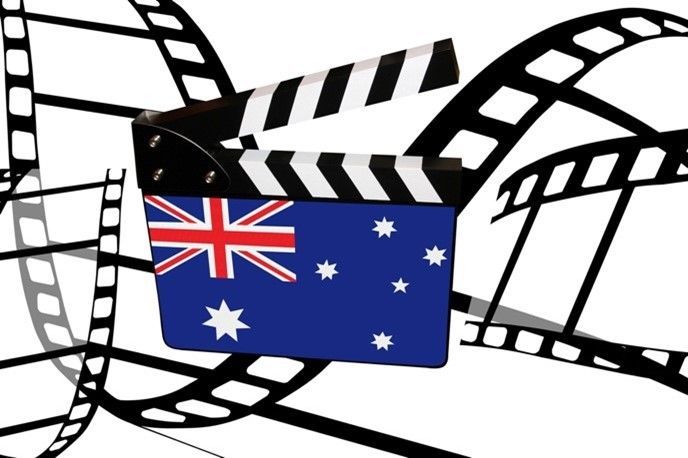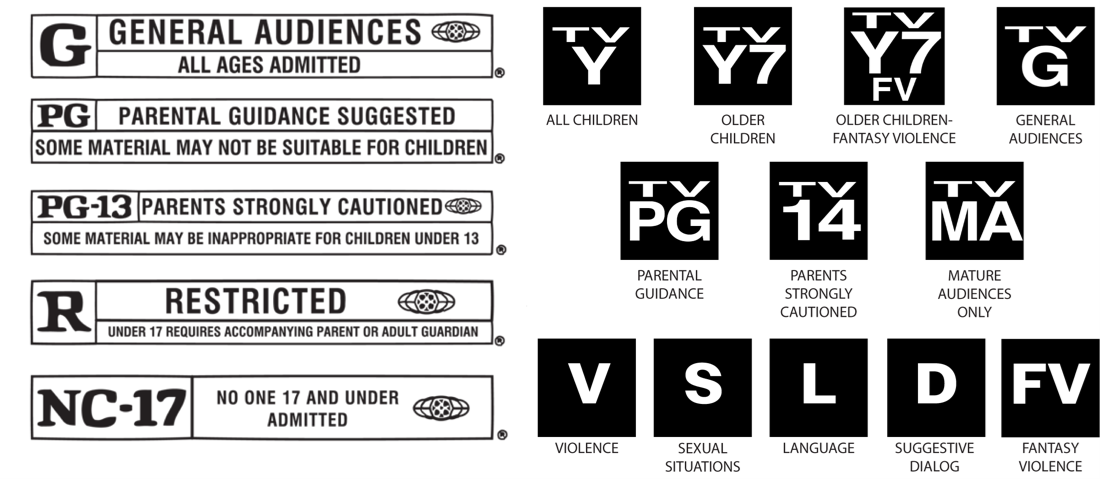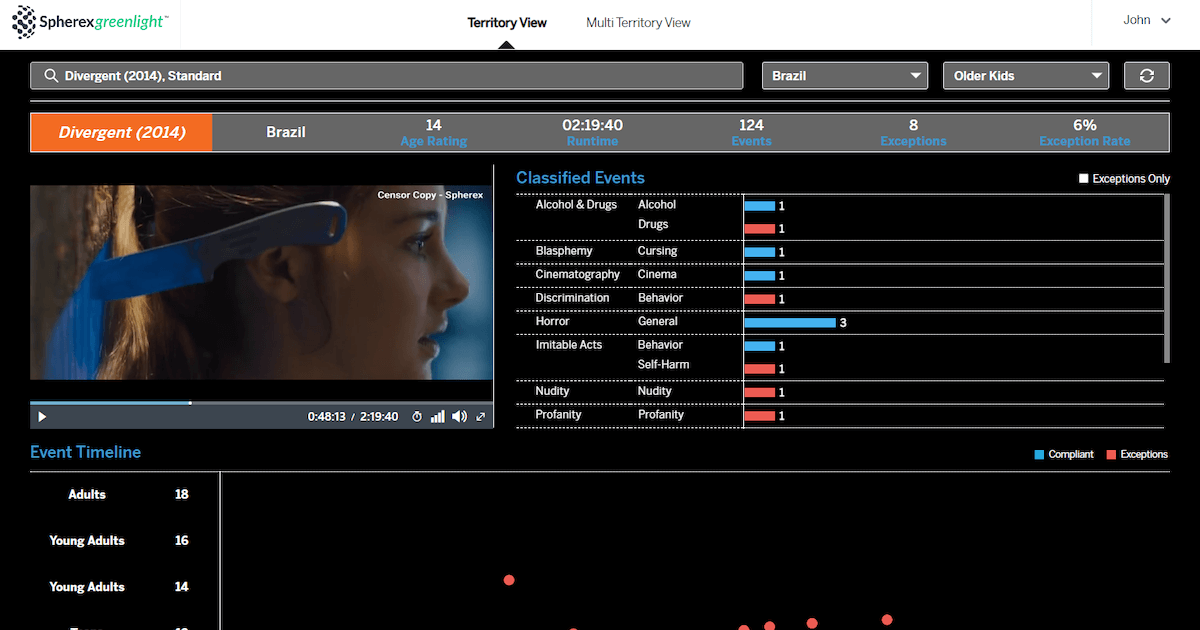Get in touch
555-555-5555
mymail@mailservice.com
Age Ratings

By Spherex
•
05 Sep, 2023
In early 2020, the COVID pandemic forced studios to rethink how and when to release major motion pictures. The pandemic cut available theaters and release times by more than half, and the industry and revenues worldwide suffered significantly. With the public no longer able to watch films in person, a new strategy for releasing theatrical films was necessary, and the "Cross-Platform Release" strategy was born. The concept is straightforward: release premium first-run titles in as many theaters as possible (if at all), then soon after on Transactional Video-on-Demand (TVOD), where consumers could buy or rent it. If a title was underperforming in certain markets, it could be released on Premium Video-on-Demand (PVOD) to help bolster awareness and revenue. Then, based on consumer response, release it on SVOD. Previously, a first-run film could be released domestically in over 4,300 theaters and run for months before it went to TVOD or SVOD. Necessity is the Mother of Invention A perfect example of this strategy is the Disney/Pixar animated film " Onward ." The film opened the weekend of 6 March 2020, in 4,310 theaters to $39.1M in revenue. Thirteen days later, it was still in 4,310 theaters, but COVID reduced daily audiences, and revenues fell to $33,296. With a budget of $175M, making $61.5M worldwide at a time when theaters were closing wasn't going to cut it. Pulled from theaters on 19 March 2020, the film was released on TVOD the next day. It was released to SVOD two weeks later. Using a combination of TVOD and SVOD, "Onward" went on to gross $142M worldwide when projections were it should have done much more. Fast forward to today when people are back in theaters (" Barbie ," anyone?), and theatrical releases compete with big-budget, first-run streaming titles. Among the lessons learned from the pandemic were studios recognized some consumers prefer watching movies at home to physically going to theaters. Consumers, especially families, were willing to wait weeks to avoid crowds and risk their health. The cross-platform release strategy allowed studios to use traditional distribution to release titles, meet consumers where they were, and extend the revenue life of films before they went to SVOD. The current movie " Meg 2: The Trench ," which, despite grossing $353M worldwide since its 4 August release, grossed just $74M in the U.S., prompting Warner Brothers to release it to TVOD 20 days later. The film was the "Top 10” TVOD title for the week ending 27 August. It's the Same, Only Different There has always been a form of the “cross-platform release strategy,” but not like today. In the “old days” of the 1980s through the late 2010s, a movie was released in the theater and then went to videotape or, later, DVD where it could be bought or rented. Streaming made wide distribution possible, and COVID accelerated consumer dependence on streaming because they had nowhere else to go for entertainment. Consumer behavior changed permanently as a result. While economics remains the critical factor, content creators and distributors that depend on international distribution to extend the financial life of their work make ensuring it is ready for global audiences imperative. Streaming and Regulation Complicates Localization and Distribution There is a lot to consider when preparing titles for cross-platform release. Not only is language translation a critical component of the process, but costs related to subtitling and audio dubbing, regulatory compliance and any required edits, multi-lingual marketing, and distribution can vary significantly across platforms. For example, a title released theatrically likely has different age rating criteria than one heading for linear or streaming distribution in the same country. Those differences can impact age ratings, watershed, and even the types of platforms or channels where it can be released. The refusal to edit or change a film’s offensive language or action to earn a lower TV age rating could force it into late evening airtime, significantly reducing audience size and advertising revenue. Navigating these obstacles requires expertise not typically available to everyone who owns or licenses content for non-native language markets. Here are some suggestions for making the process go more smoothly. First Things First The first step in solving a problem is understanding it. Last year, we discussed the five key steps to preparing a global release title. In that post, we share the hows and whys for thinking about international releases early in the production process, learning as much as possible about your audience, and not being afraid to ask for help. These tips are as relevant today as they were a year ago. Failing to Plan is Planning to Fail The time required to prepare an original film or TV series for international release is substantial. While localization is the most time-consuming part of the process and can take months, other overlooked components exist. There can be fundamental differences between literal script translation and addressing cultural issues that will impact ratings. For example, how drugs are used or represented matters to audiences, and regulators in dozens of countries worldwide can be stringent in ensuring the audience doesn’t see something they shouldn’t. Failure to know those differences and plan accordingly is sure to impact its age rating, its audience, and your revenue. Think Locally, Plan Regionally Spherex is helping creators streamline the global distribution process by identifying cultural events within titles that are problematic for audiences and regulators. One of the things we’ve found is that while localization is “local,” there are regions where similar sensibilities exist. If you consider where films are being censored or banned for specific types of content, you’ll note many countries have similar cultures, religions, forms of government, and regulations. Using the Spherex AI platform, you can identify similar markets; and instead of creating separate versions for individual countries, you may be able to prepare a single release and distribute it regionally. This strategy expands your content’s markets and further monetizes it, reducing post-production localization and distribution expenses. Cross-platform releases are here to stay. It results from the COVID-19 pandemic, such as the broader adoption of streaming as an entertainment source and a significant change in consumer behavior. After a title has run its theatrical course, there are plenty of opportunities to reach even larger audiences using this strategy. Spherex is the only AI platform with years of experience providing the intelligence and guidance creators and studios need to ensure their content reaches the largest audience with the lowest brand risk. The secret is knowing and planning. Click here to learn more about how Spherex can help your titles succeed.

By Spherex
•
09 Jun, 2023
In a 2022 government survey of 2,000 Australians, the Australian Classification Board (ACB) learned that consumers wanted more up-to-date classification information reflecting community standards and "specific warnings that content could be distressing to some people." Examples included scenes with "bullying, suicide or self-harm, as well as disturbing content related to horror, or blood and gore." Responding to the feedback, the ACB announced on 25 May 2023 that it would significantly expand consumer advice on all rated movies. The additional advice does not apply to TV shows or games. The ACB disseminates guidance in two ways. First, it publishes consumer advice details on the movie's page on its website. Second, the film's rating and list of content warnings appear before the start of each movie, whether exhibited theatrically or online. What the Expanded Consumer Advice Looks Like One of the first titles to receive this additional consumer advice is the film " The Pope's Exorcist ." The ACB assigned it an "MA15+ Restricted rating," restricting audience attendees to those over age 15. The film label includes the previous standard of "strong horror themes and bloody violence." Before the new guidance went into effect, those five words were the extent of official notice. The consumer advice now includes additional details about the film:

By Spherex
•
10 May, 2023
Due to government-mandated regulations, exporting content to international markets poses a significant challenge for many in the Media and Entertainment (M&E) industry. These regulations can take different forms and are intended to guide the public on the age appropriateness of film or TV titles. From a creator and distributor perspective, keeping up with the changes and understanding their rationale requires skills and knowledge outside their core competency. Non-compliance can result in financial penalties and is complicated because regulations are subject to change, and no two countries implement rules similarly. This post explores three types of changing regulations globally: local content requirements, prohibitions on Diversity, Equity, and Inclusion (DEI) content, and revised age-rating criteria. Local Content Requirements As the streaming industry continues to grow, platforms are investing billions of dollars in attempts to produce original content. Stories that resonate with audiences are more likely to attract their attention. Regulators have noticed and are implementing new regulations to secure their share of the economic benefits and require investment in local productions. Local content requirements exist in many countries, including Canada, France, Denmark, Australia, and India. Canada recently passed Bill C-11 , " the Online Streaming Act ," which brings streaming platforms under the Canadian Radio-television and Telecommunications Commission (CRTC) regulatory authority for the first time. The CRTC now requires content creators to prove that each piece of content meets Canadian standards, and streaming platforms ensure search algorithms prioritize Canadian content. Fines can be imposed for non-compliance. Diversity, Equity, and Inclusion Despite the M&E industry's support for DEI, many governments worldwide have continued restricting or prohibiting content depicting LGBTQ characters or storylines in film or TV shows. Successful films with diverse stories or leads, such as " Black Panther: Wakanda Forever " and " Strange World ," have been banned or require higher age ratings in countries such as Russia, Saudi Arabia, Singapore, Iran, and the UAE. Although recent studies indicate gains in Hollywood, others show DEI improvements in British Columbia and European productions have been slow to take hold. In the U.S., some states, including Florida and Texas, have passed laws that limit how LGBTQ+ or race-related issues can be shown or discussed in educational institutions or venues. This includes prohibitions on public access to books, videos, or films mentioning aspects of LGBTQ+ life and the performance of plays or movies with diverse stories or leads. Age-Rating Regulatory Changes Content classification regulations are being revised in countries worldwide to expand the number of age groups they consider and to ensure content is more appropriately classified in order to meet the country's cultural and legal requirements. Vietnam's Ministry of Culture, Sports and Tourism (MCST) announced it added two new age groups to the existing four: P (all ages), 13+, 16+, and 18+. The new categories are "K" for viewers under 13 and "C," indicating a film cannot be distributed. More specific classification criteria will accompany the new age groups on topics or content such as violence, nudity and sex, drug use, horror, offensive language, and dangerous imitable behavior. The rating criteria for nudity and sex have expanded to consider the age of the characters and their possible impact on the viewer. In addition to the classification changes, all titles, except films rated "P," must now prominently display the classification level " during the dissemination process ," which means trailers, ads, posters, etc. The content shown on TV or streamed must now exhibit the classification label within three seconds of airing and then three times over the course of the showing if the title is longer than 20 minutes long. The new regulations are available here . India's Union Cabinet has announced it will begin amending the 1952 Cinematograph Act to add three new sub-categories to the existing "UA" rating. The new sub-categories UA 7+, UA 13+, and UA 16+ provide more details to parents or guardians and take Indian culture and norms into account. The "UA" classification is analogous to the "Parental Guidance" or PG rating in the U.S. and provides guidance on whether a film is inappropriate for children under 12. The IT Rules of 2021 already require streaming services to use these age classifications with content descriptors, and the amendment would bring cinema ratings on par with streaming. The Importance of Staying Current Navigating the regulatory landscape is challenging for content creators, who must stay informed and adapt to changing regulations to succeed in global markets. Failing to comply with country regulations and policy changes can delay a title's release, increase post-production costs, adversely impact market acceptance and revenue, and damage a brand. Few content companies have the expertise or capacity to stay current on all changes affecting global M&E markets, but Spherex has you covered. Subscribe to World M&E News to have the latest international regulatory news delivered directly to your inbox. If you have content you want to distribute globally, Spherex ratings ™ and Spherex greenlight ™ are the best tools available to prepare your titles to ensure audience acceptance and reduce brand risk. Contact Spherex today to learn more.

By Spherex
•
23 Feb, 2023
The French writer Jean-Baptiste Alphonse Karr wrote in 1849 , "the more things change, the more they stay the same." Writing about the social changes occurring in France at the time, his point was that nothing changes without a fundamental shift in knowledge and thinking. Here at Spherex, we closely monitor changes in new legislation, policies, or public sentiment in countries worldwide because it directly impacts a title's age rating , the potential for censorship or unfavorable press, and revenue opportunities. Awareness is the first step in avoiding legal or brand exposure. Since we last wrote on this subject six months ago , some changes have occurred, but much remains the same. Here are recent examples of what we mean. The More Things Change – Malaysia Malaysia's Film Censorship Board (LPF) announced new film and online content ratings in January 2023 that took effect on 1 February 2023. The ratings established five classifications, an addition of two from the previous three: 1. "U" for viewers of all ages 2. "P12" for viewers under 12 years old that required parental guidance (new) 3. "13" for audiences 13 years and older 4. "16" for viewers 16 years and older (new) 5. "18" for viewers 18 and above The changes were a response to content creators expressing that the previous classification system made it impossible to include some scenes without compromising the story. Time will tell how the new system will affect the LPF's view of titles similar to those previously banned , e.g., "Thor: Love and Thunder" and "Lightyear." The first test may be the upcoming Malaysian film " Pulau ," which critics say contains many indecent scenes unsuitable for public viewing . The objectionable scenes include "sexualized kissing" and women wearing bikinis. Some Malaysian officials have already called for it to be banned . The film is scheduled for release next month. The More They Stay the Same – Jordan Netflix, which continues to invest in international content creation, must find a way for local stories to gain global appeal . The company's most-watched title for the past month in Jordan is " Al Hara (The Alleys)." As a locally produced title, the film, while popular with audiences, has been subjected to condemnation by members of the Jordanian Parliament for the inclusion of offensive words and profanity, despite having been approved by Jordan's Royal Film Commission (RFC). The Jordanian Media Authority removed all profanity and scenes that deviated from the values of Jordanian society from the movie before its theatrical release. Netflix’s version restored those scenes, which is the source of controversy. Things Really Don't Change at All – United States From religious beliefs to local traditions to family values to moral standards, ensuring content respects societal norms is a boundary local regulators or censors are keen to safeguard. Sometimes, countries choose to protect these boundaries through legislation when they perceive censorship is being used to compromise the country’s standing in the world or influence their film industry. Last December, the U.S. Congress passed, and the President signed, the " National Defense Authorization Act for Fiscal Year 2023 ." The act prohibits any U.S. federal agency from knowingly supporting the production of any film, television, or other entertainment project explicitly edited to appease Chinese governmental censors. Specifically, Section 1257 of the law states: "None of the funds authorized to be appropriated by this Act may be used to knowingly provide active and direct support to any film, television, or other entertainment project if the Secretary of Defense has demonstrable evidence that the project has complied or is likely to comply with a demand from the Government of the People's Republic of China or the Chinese Communist Party, or an entity under the direction of the People's Republic of China or the Chinese Communist Party, to censor the content of the project in a material manner to advance the national interest of the People's Republic of China." This language was inserted into the law because some members of Congress wanted to codify their displeasure with China's practice of demanding edits of scenes it felt were critical of the country, such as its censorship of the film, " Top Gun: Maverick ," among others. The Media & Entertainment (M&E) industry attempted to remove the language from the bill because it included increased government editorial control over the script. The concern among studios is that this provision will make it more challenging to export titles, thus reducing revenue opportunities for US-produced films. Censorship is happening around the globe, and the extent of its effect can vary widely. It can directly impact how, where, and when stories are told. For those unwilling or unable to make changes, failing to comply with requested or required edits, cuts, bleeps, or blurs will negatively impact the title’s bottom line, regardless of the method or platform. While no one likes changing their story to appease public or political concerns, knowing the issues and possible remedies is the best way to deal with them. Regardless of a title's production stage, Spherex has the cultural and regulatory expertise to assist content creators in navigating this ever-evolving landscape. Contact us today to learn more.

By Spherex
•
01 Feb, 2023
Spherex's patented Spherex greenlight ™ AI/ML content analysis technology provides frame-level cultural feedback to content creators, distributors, and platforms so that titles can be adequately prepared for distribution to any country worldwide without regulatory or brand risk. Creators can use this technology at any stage of production to be alerted to events within the title that audiences or regulators may find objectionable. They can then decide how to address those issues before public release. Spherex greenlight ™ is simple to use, its output easy to understand, and the technology behind it is truly extraordinary. This post describes what Spherex greenlight ™ looks for in video content (we call them events) and how it interprets events that could result in cultural, political, or regulatory issues. Culture matters. Analyzing scenes through a cultural lens is critical to determining content audience suitability for local markets. For film and television, the type, portrayal, and intensity of cultural events determine the familiarity and acceptance of foreign content. How a title is perceived by government regulators and the public directly impacts distribution opportunities, market reach, audience size, public relations, and revenue. Events are the foundation. Events are components of a scene that include dialogue, music, lighting, acts of violence, sexuality, and drug use, among others, that tell the story. Think of events as subjects plus action, surrounded by context. A gunfight is an event. A love scene is an event. An argument containing profanity is an event. As interpreted by each country's culture and rules, the frequency, intensity, and impact of events determine the respective age ratings for a title. Take drug use, for example. Images of someone using a drug prescribed by a doctor (like an antibiotic) versus one used recreationally (like nicotine or marijuana) or in an abusive manner (like methamphetamine) all uniquely contribute to the intensity or impact of an event. Illicit drug use that is implied, shown as occurring in the shadows, or results in negative consequences may be suitable for all age groups in some countries but only for teenagers and above in other countries. The magic is knowing how each event is interpreted culturally and then applying each country's respective laws and rules to determine the appropriate age rating. Multiply that example across 200+ countries and territories, 7,151 known languages, and 3,800 distinct cultures, and you begin to see the value of Spherex greenlight ™. People interpret events differently based on their language, traditions, beliefs, and laws. There are hundreds of classifiable events to understand in preparing a title for international release. Context is often the final arbiter. Context is the circumstances that form the setting for a situation or event – and thoroughly explain it. Lighting, environment, era, consequences, character portrayal, colors, and more all contribute to describing the context of an event and are perceived differently by cultures worldwide. Contextual cues for age ratings may involve the environment, the character's prominence, the plot's importance, and whether an objectionable event is glamorized or encouraged. Context is critical to the arithmetic of computing an event. It will either be an aggravating or mitigating factor and, thus, raise or lower the formulated age rating. Event exceptions introduce risk. "Exceptions" are events that contain objectionable content according to a country's culture, politics, or laws. Exceptions cause regulators to restrict content to adults, require compliance edits before distribution, or entirely ban a title in some cases. Compliance edits can be bleeps or blurs that have little impact on the story. Or they could entail cutting scenes or reshoots, depending on the form and degree of objectionable content. Showing the Taiwanese flag on a jacket for a few seconds got Paramount Studio's " Top Gun: Maverick " banned in Mainland China but had no impact anywhere else. Two words in a single line of dialogue mentioning a same-sex girlfriend in Disney's " Onward " was enough to get the film banned in multiple countries. Even the cultural miscues in Netflix's "Squid Game" indicate how exceptions impact audience and media response to a title. Ideally, potential exceptions are identified during the script or production stages to mitigate compliance-related delays and costs. Knowing the concerns allows the director to address potential issues to avoid regulator scrutiny and reach the broadest audience in every market while staying true to their vision and the story. The difference in audience size of a film released in Germany rated age 12 compared to one rated age 16 is three million people. If similar ratings have similar population differences in multiple countries, making compliance edits can expand audience reach by millions. Because reach and engagement are vital determinants of success, knowing where to make edits to reach broader audiences is invaluable information, especially before issues arise. Making global distribution more successful. Few issues are more crucial to content creators than maintaining creative control and distributing their work. As global demand for content increases, those creating it will come face-to-face with the realities of international distribution. The first roadblock they will encounter is content regulators. Only Spherex greenlight ™ provides the insights necessary to ensure story integrity and cultural compliance and does so in a way that makes global distribution more successful. Contact Spherex today to schedule a live demonstration.

By Entertainment Globalization Association
•
03 Jan, 2023
Spherex , a global entertainment technology and data company, will demonstrate Spherex greenlight ™, which is its revolutionary expert-in-the-loop artificial intelligence (AI) and machine learning (ML) solution, at Pepcom’s Digital Experience! at CES. Spherex greenlight ™ opens borders for content. Using AI, the technology highlights culturally sensitive and objectionable scenes and predicts how a movie or TV show will be perceived by audiences worldwide. Spherexgreenlight™ ensures that studios, TV networks, and streamers reach the broadest audiences in each local market, comply with content regulations, and avoid censorship – all while protecting their brand reputations and identity – to maximize the value of content. Led by CEO/Co-Founder Teresa Phillips , Spherex set out over a decade ago to develop the world’s first cultural playbook for Media & Entertainment. Through mining thousands of policy manuals, historical literature, local film/TV classifications, current affairs, judiciary decisions on sensitive topics (e.g., LGBTQ, sexual violence, self-harm, drug use, and more) in 100+ countries, Spherex has created an enterprise system for screening and annotating content. While understanding content in video remains a high hurdle in AI, Spherex has implemented a multi-modal architecture that analyzes image/video, audio signals, and text as inputs to generate a unique fingerprint of a title. The content analysts at Spherex hand-curate these models based on specific pieces of content like subjects, objects, events, actions, sounds, words, tone, and more. Spherex’s ML-based rules engine is the controller that determines how territory-specific rules are applied accurately to a given title’s cultural fingerprint. Blending AI and ML systems with a comprehensive understanding of the cultures and complexities present in the global regulatory environment, Spherex is future-proofing the media and entertainment industry while keeping up with the unprecedented international growth in video content, distribution, and consumption. Where to find Spherex at CES 2023: Pepcom Wednesday, Jan. 4, 7:00 – 10:30 p.m. Location: Caesars Palace ABOUT SPHEREX Spherex is a global entertainment technology and data company transforming how media and entertainment enterprises create, adapt and deliver film and television to audiences worldwide through expert-centered AI and machine learning. With unmatched expertise in cultural adaptation, ratings, metadata and title monitoring, Spherex works with the world’s largest media companies, movie studios, networks, distributors and streamers to build larger audiences, speed up content discovery, drive more video views and generate higher revenue. Learn more at www.spherex.com . Source: Entertainment Globalization Association
SILICON VALLEY
2336-H Walsh Ave.
Santa Clara, CA 95051
+1(408) 550-2344
LOS ANGELES
3900 W Alameda Ave.
Burbank, CA 91505
+1(310) 496-7307




